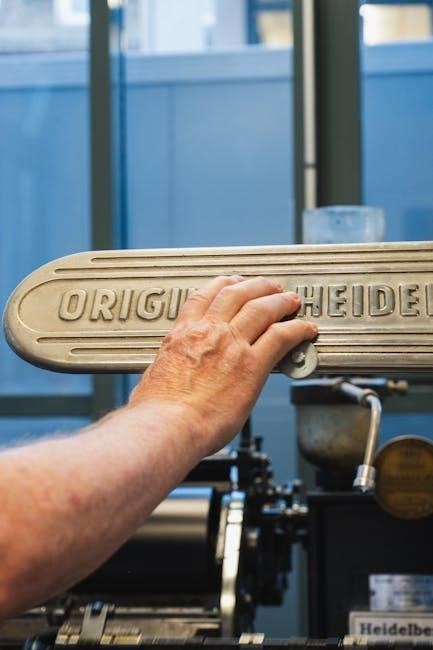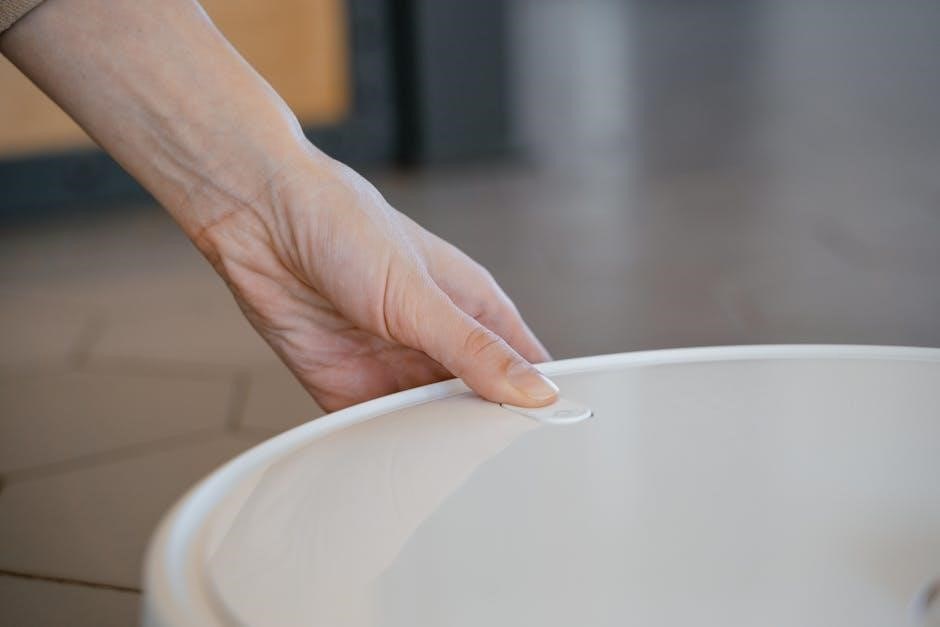Crock-Pot Original Slow Cooker Manual: A Comprehensive Guide
This guide provides comprehensive information about your Crock-Pot Original Slow Cooker․ Learn about its features, operation, maintenance, and discover delicious recipes․ Maximize your slow cooking experience with this essential resource․
The Crock-Pot Original Slow Cooker has revolutionized home cooking, offering a convenient and efficient way to prepare delicious meals with minimal effort․ This appliance is a staple in kitchens worldwide, known for its simplicity and reliability․ The manual Crock-Pot slow cooker comes with basic temperature settings: low, high, and warm․
This comprehensive guide aims to provide you with a thorough understanding of your Crock-Pot, from initial setup to mastering various cooking techniques․ Whether you are a seasoned chef or a beginner cook, this manual will help you unlock the full potential of your slow cooker․ Learn how to adapt recipes, troubleshoot common issues, and maintain your appliance for long-lasting performance․
The original Crock-Pot slow cooker remains a beloved choice for those seeking a simple, reliable, and time-saving cooking solution․ This guide is designed to provide you with all the information you need to confidently use and care for your Crock-Pot, ensuring countless delicious meals for years to come․
Overview of Manual Slow Cookers
Manual slow cookers represent the foundational technology in slow cooking, offering a straightforward and dependable approach to meal preparation․ Unlike their programmable counterparts, manual slow cookers operate with a simple on/off switch and a limited set of temperature settings, typically including low, high, and warm․ This simplicity makes them exceptionally user-friendly, requiring minimal setup and programming․
The absence of complex features also contributes to their durability and longevity․ Manual slow cookers are less prone to electronic failures, making them a reliable choice for everyday cooking․ While they may lack the advanced functionalities of programmable models, their consistent performance and ease of use remain highly valued by many home cooks․ Understanding the basic operation of a manual slow cooker is essential for mastering the art of slow cooking․
These appliances are ideal for preparing a wide range of dishes, from hearty stews and tender roasts to flavorful soups and casseroles․ Their consistent heat distribution and long cooking times allow for deep flavor development, resulting in delicious and satisfying meals․
Key Features of the Original Crock-Pot
The Original Crock-Pot boasts several key features that have made it a kitchen staple for generations․ Its hallmark is the removable stoneware insert, crucial for even heat distribution and easy cleaning․ This insert allows food to cook gently over extended periods, developing rich flavors and tender textures․ The Original Crock-Pot offers simplicity with its manual controls, typically featuring low, high, and warm settings, providing straightforward operation without complex programming․
The tempered glass lid seals in moisture and heat, ensuring consistent cooking and allowing cooks to monitor progress without disturbing the cooking process․ Stay-cool handles make transporting the Crock-Pot safe and convenient․ Available in various sizes, the Original Crock-Pot caters to different household needs, from small families to large gatherings․
Its durable construction ensures long-lasting performance, making it a reliable appliance for everyday use․ The classic design and simple functionality of the Original Crock-Pot make it an enduring favorite for slow cooking enthusiasts․

Understanding the Manual
This section guides you through the Crock-Pot manual․ It highlights important safety precautions․ Also, it explains how to properly use your slow cooker․ Understanding the manual ensures safe and optimal operation․
Navigating the Instruction Manual
The instruction manual accompanying your Crock-Pot is your first point of contact for understanding how to safely and effectively use your slow cooker․ Begin by familiarizing yourself with the table of contents, which provides a roadmap to the manual’s key sections․
Pay close attention to the sections detailing safety precautions․ These will prevent accidents during the usage․ Look for sections that explain the different cooking modes, such as low, high, and warm, and how to adapt your favorite recipes for slow cooking․
The manual typically includes diagrams illustrating the parts of the slow cooker and troubleshooting tips for common issues․ Additionally, explore any sample recipes or cooking charts included, as they offer practical guidance for achieving optimal results․
Refer to the model number search in the manual to identify specific instructions relevant to your Crock-Pot model․ By carefully navigating the instruction manual, you’ll gain the knowledge and confidence to enjoy countless delicious and hassle-free meals․
Important Safeguards and Safety Precautions
Prioritize safety when operating your Crock-Pot․ Always read all instructions before use․ Never immerse the appliance base in water or other liquids to prevent electric shock․ Close supervision is necessary when the appliance is used near children․ Unplug the Crock-Pot when not in use and before cleaning․
Allow it to cool completely before handling or cleaning․ Avoid using the slow cooker if the cord or plug is damaged․ The use of accessory attachments not recommended by the appliance manufacturer may cause injuries․ Do not use outdoors․
Place the Crock-Pot on a stable, heat-resistant surface away from flammable materials․ Do not touch hot surfaces; use handles or knobs; The lid handle may get hot; use an oven mitt․ Avoid sudden temperature changes, such as adding cold food to a preheated stoneware․
Never reheat foods in the slow cooker, unless specified․ Do not let the cord hang over the edge of the table or counter․ Following these safeguards ensures safe and enjoyable use of your Crock-Pot․

Operating Your Crock-Pot
Learn how to safely and effectively operate your Crock-Pot․ Understand the initial setup, cooking modes, and how to adapt recipes for slow cooking to create delicious meals with ease․
Initial Setup and First Use
Before using your Crock-Pot Original Slow Cooker for the first time, it’s essential to follow a few initial setup steps to ensure safe and optimal performance․ Begin by carefully unpacking all components, including the stoneware insert and lid․ Thoroughly wash the stoneware and lid with warm, soapy water, and ensure they are completely dry before use․
Next, inspect the slow cooker’s base for any visible damage․ Place the stoneware inside the base, ensuring it sits securely․ Before plugging in the slow cooker, read the important safeguards and safety precautions outlined in the manual․ For the first use, it’s recommended to fill the stoneware with water and run the cooker on high for about an hour․ This helps to eliminate any manufacturing odors․ After the initial run, discard the water, and your Crock-Pot is ready for its first culinary adventure․ Always remember to place the chicken in the slow cooker and squeeze lemon juice over it;
Cooking Modes: Low, High, and Warm
The Crock-Pot Original Slow Cooker offers three primary cooking modes: Low, High, and Warm, each designed for different cooking needs․ The Low setting is ideal for long, slow cooking, typically ranging from 6 to 8 hours or even longer․ It’s perfect for tougher cuts of meat, allowing them to tenderize over time, and for recipes where flavors need to meld deeply․
The High setting cooks food at a higher temperature, reducing cooking time to approximately 3 to 4 hours․ This is a good option when you need a quicker meal or for recipes with more delicate ingredients that don’t require extended cooking․ Once cooking is complete, the Warm setting keeps food at a safe serving temperature without overcooking․ It’s perfect for buffets or keeping dinner ready until everyone is ready to eat․ Remember that you can add milk, cream and sour cream during last hour of cooking;
Adapting Recipes for Slow Cooking
Adapting your favorite recipes for slow cooking with your Crock-Pot Original Slow Cooker is easy with a few adjustments․ Remember that most uncooked meat and vegetable combinations will require at least 8 hours in the slow cooker․ Reduce liquids by about one-third, as slow cookers trap moisture․ Browning meats beforehand can enhance flavor and appearance․
Adjust cooking times: If a recipe calls for 1-2 hours of simmering on the stovetop, cook it on High for 1-2 hours or on Low for 4-6 hours․ For recipes requiring 3-4 hours of simmering, cook on High for 2-3 hours or on Low for 6-8 hours․ Add delicate ingredients like pasta, dairy, and fresh herbs towards the end of the cooking time․ Always remember, the size of the meat is just an estimate․

Maintenance and Care
Proper maintenance ensures the longevity of your Crock-Pot․ Regular cleaning and addressing common issues will keep your slow cooker functioning optimally․ Follow these guidelines for the best performance and years of use․
Cleaning Your Crock-Pot
Maintaining a clean Crock-Pot is essential for food safety and optimal performance․ Always unplug the slow cooker and allow it to cool completely before cleaning․ The stoneware insert and glass lid are typically dishwasher-safe, offering convenient cleaning․ However, hand-washing with warm, soapy water is also effective․ Avoid using abrasive cleaners or scouring pads, as they can damage the surface․
For stubborn food residue, soak the stoneware in warm, soapy water before cleaning․ A mixture of baking soda and water can also help remove baked-on food․ Ensure the base unit, which houses the heating element, never gets immersed in water; instead, wipe it down with a damp cloth․ Dry all parts thoroughly before reassembling․ Regular cleaning prevents odors and ensures your Crock-Pot remains ready for the next delicious meal․ Do not preheat Crock-Pot slow cooker before using․
Troubleshooting Common Issues
Encountering issues with your Crock-Pot? Let’s troubleshoot․ If your slow cooker isn’t heating, first check the power cord and outlet․ Ensure the unit is switched on; If it still doesn’t heat, the heating element might be faulty, requiring professional repair․ Food cooking unevenly could be due to overcrowding; ensure ingredients are in a single layer․
If food is overcooking, reduce cooking time or use the ‘Warm’ setting․ If food is undercooked, increase cooking time․ If the lid doesn’t fit properly, check for cracks or warping, consider a replacement․ Steam escaping excessively? Ensure the lid is securely placed․ Food sticking? Add more liquid or use cooking spray․ If you notice a burning smell, unplug the Crock-Pot immediately and investigate the cause․ Contact customer service or consult the manual for further assistance․ Remember never to immerse the base in water․

Recipes and Cooking Tips
Discover a variety of delicious recipes perfect for your Crock-Pot․ From hearty stews to savory roasts, explore cooking tips and techniques to create flavorful meals with ease․ Enjoy simple, satisfying slow-cooked dishes․
Sample Recipes from the Cookbook
Explore a delightful selection of sample recipes taken from the Crock-Pot, The Original Slow Cooker Cookbook and Owners Manual․ These recipes offer a glimpse into the culinary possibilities of your slow cooker, ranging from savory main courses to comforting desserts․ Discover the ease and convenience of preparing delicious meals with minimal effort․
One standout recipe is Swiss Steak, featuring tender round steaks slow-cooked with onions and flavorful seasonings․ Another classic is Pot Roasted Pork, a hearty dish perfect for family dinners․ For poultry lovers, Herbed Turkey Breast offers a succulent and aromatic option․ Don’t miss Chicken with 40 Cloves of Garlic, a surprisingly mild and incredibly flavorful dish․
Vegetarian options include Country Scalloped Potatoes and Ham, a creamy and satisfying side dish, and Stuffed Green Bell Peppers, filled with a savory rice and vegetable mixture․ These sample recipes showcase the versatility of your Crock-Pot, empowering you to create a wide range of dishes with ease and consistent results․


